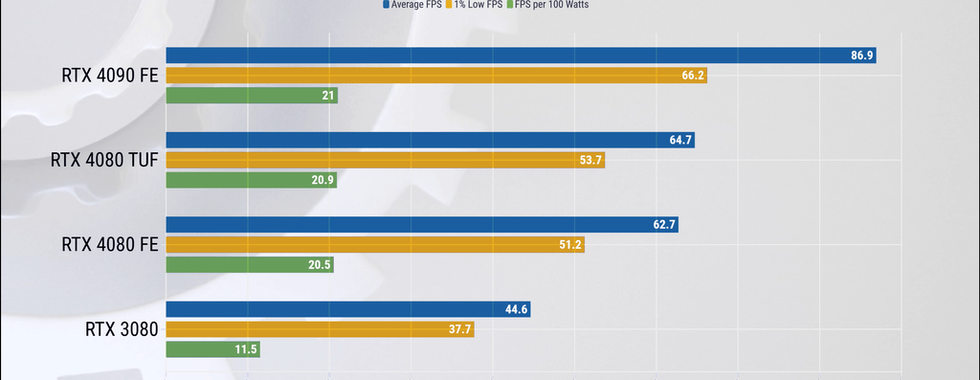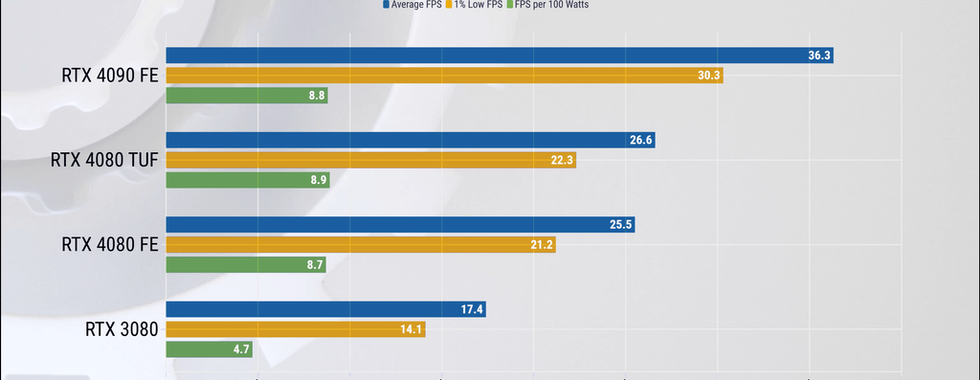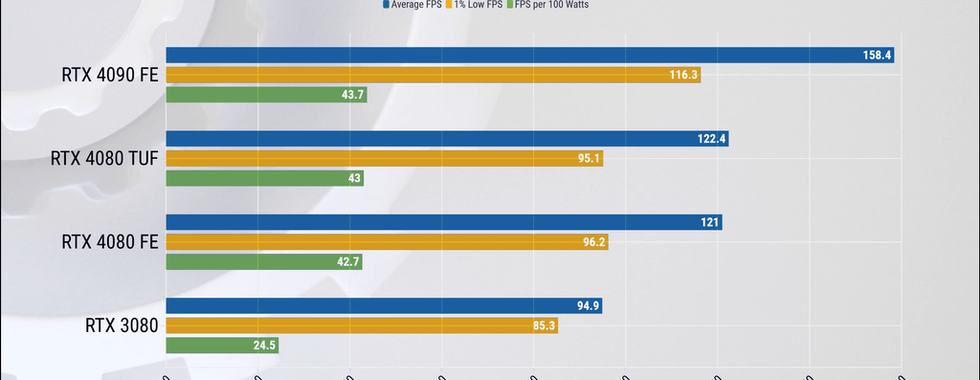RTX 4080 FE vs TUF Gaming 4080 OC Performance || If I Was ASUS, I Would Be UPSET
- A2K
- Nov 24, 2022
- 5 min read
Updated: Aug 30, 2023
Since we managed to secure two review samples of RTX 4080, including Founders Edition directly from NVIDIA - we decided to make a review comparing them head to head for those who may be interested to pick one up. At the same time this should give you an indication of overall performance and compare it to the last gen 3080 and the current king in GPU performance the RTX 4090. And spoiler alert - one of these RTX 4080s is actually slightly better than the other. Let’s get right into it.
Before we get into the testing results, here is our Ryzen 7 7700X test bench.

I want to first start with power targets between Founders Edition and TUF Gaming cards. For this we ran Firestrike Ultra on loop and found that both of them kept swapping back and forth, but ultimately TUF Gaming card hit a peak of 317W while FE card peaked at just below 314W, so they are pretty even in this regard.
When it comes to cooling and fan speeds, we have TUF Gaming actually running both fans considerably faster than the Founders Edition during this test. What is interesting, on the Founders Edition fans are running at different speeds. Fan 1 is about 100 RPM faster than Fan 2 when speeds stabilise.
And TUF gaming fans are 155 RPM faster than the fastest fan on the FE card. You would think a 10% speed difference would make it much louder but that is not the case. In our measurements the sound difference is only 0.4 dBA and both of these cards stayed below 38 dBa while under load which is pretty quiet.
The keen eyed among you probably already spotted that we only show two fans on TUF card even though it has 3. It is because speeds are being reported from the middle fan as one measurement and flanking fans together as the other measurement.
Due to more and faster fans the TUF Gaming card actually on average performs 2 degrees cooler than the Founders Edition card. This is considering that our room's ambient temperature is 26 degrees Celsius.
When we look at the frequency, the ASUS card is also running slightly faster than its Nvidia counterpart. The average difference is about 53 MHz which is just short of 2%. I suspect that’s where that TUF Gaming OC comes in.
So when it comes to power targets these cards are comparable but TUF gaming so far has a slight thermal advantage. To verify this, we ran both cards tuned to the same 40 dBa noise target and found almost the same results. The temperature delta is 2.5 C which is 3.8% and frequency is about 2% higher on the TUF Gaming card.
So with this in mind - how does that transfer in the real world performance? Let's do some game benchmarks, starting with Shadow of the Tomb Raider at 1440p - here we see TUF card leading by 1.8% on average FPS and losing by just shy of half percent on the one percentiles. If we look at the 4090 - it is leading the pack by only 16.5 percent while having 29% higher MSRP from the Founders Edition.
When we increase resolution to 4k, the difference between 4080s stays roughly the same at 1.6% lead from the ASUS card. In this example RTX 4090 is 35% faster which is a similar difference that we have from 3080 to 4080.
In Horizon Zero Dawn at 1440p there is similar difference between TUF and FE cards, but we are mostly limited by the CPU above that so we are not going to spend much time here, but at 4K there is a whole 1% improvement from Founders Edition to TUF Gaming card and just shy of 30% improvement from RTX 4090.
Moving forward we will run things only in 4K as this is where I feel these cards are supposed to be used. In Overwatch we have one of the biggest differences of 2.8% lead from the TUF Gaming card over the Founders Edition and only 4.2% improvement by going up to RTX 4090.
Next we have some more modern titles with Ray Tracing enabled, here in F1 2022 at maxed out settings we see much lower frame rates, and the extra speed from TUF Gaming card allows for 3.1% improvement over FE while being 34.3% slower than RTX 4090. This performance scaling is very close to the price scaling.
While keeping the same settings, we enabled DLSS to Performance Mode and also turned on frame generation on the 4000 series cards and here we yet again have 2% improved average FPS on the TUF Gaming card while RTX 4090 is running 25% faster.
In Cyberpunk 2077 we also maxed out the settings and pushed Ray Tracing to what they call Psycho Mode and here these cards get properly punished. With these settings it's not really a pleasant experience on either one of the cards. With this in mind, ASUS card is 4.1% faster than Founders Edition and RTX 4090 is leading the pack with 36.5% more FPS on average.
With the full DLSS suite of features enabled, the game becomes playable again and this is the first time Founders Edition card is actually performing better than TUF Gaming. It had 3.4% lead on average FPS and 1.2% on 1 percentiles. RTX 4090 is 31.2% faster than 4080 FE here.
Now let’s do a quick fire round for productivity and summarise all of these results. Feel free to pause and check out the actual graphs as we zoom by them. The long story short here is that TUF Gaming is between 0.8 and 1.4 percent faster than the Founders Edition card which is somewhat in line with the previous tests we did.
After doing all of these tests it becomes quite apparent that there is no funny business happening with the actual GPU chips themselves, and both cards perform really closely. Since the TUF Gaming card is more expensive than the Founders Edition card from NVIDIA, it is slightly faster in all but one test which was Cyberpunk 2077 at maxed out settings with DLSS and frame generation turned on. Other than that - you can expect a few percent better performance at almost identical noise levels. The ASUS card is also bigger so here is that. Overall if that is worth it or not is a very TUF choice.
When it comes to RTX 4080 value if compared to RTX 4090, this gets rather interesting. We will use the two Founder Edition cards for comparison as both of their pricing is known. So based on MSRP of 1200 USD for the 4080 FE and 1600 USD for the 4090 FE, the difference is around 28.5% and as you can see in this table, in most of the tests scaling of performance per dollar lines up, in fact you get more performance per dollar from the 4090 which makes 4080 a pretty expensive card. I believe at this current time with 1200 USD price tag this card (while still performing ok) is more of a nudge for people to get 4090 which is really expensive.
My ultimate recommendation for now is to hold off unless you really need Nvidia specific features. In under a month AMD will have their next gen Radeon cards out in the market and this will likely shake things up. If on the other hand 4080 price were to drop to 1000 USD, then it would actually be better value per dollar than 4090 which I suspect may happen after the AMD launch. We shall have to wait and see.





















































Comments